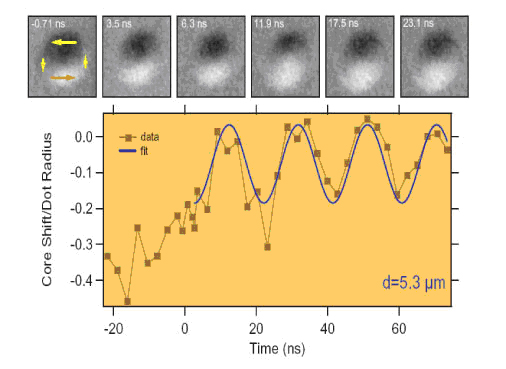Micron and nanosized magnets are of great interest for their potential applications in new electronic devices, such as magnetic random access memories. As the size of magnets is reduced to a 1-micron scale and below, the boundaries (surfaces, perimeters, etc) of the objects begin to profoundly influence both the static and dynamic behavior of the materials. Researchers from Argonne’s Materials Science Division (MSD), Center for Nanoscale Materials (CNM), and Advanced Photon Source (APS) have recently examined the dynamics of 3- to 7-micron-diameter NiFe alloy disks with a combination of theoretical calculations and a new time-resolved magnetic imaging technique using synchrotron-based x-ray photoemission electron microscopy (PEEM). These structures, which are a few microns in diameter, exhibit a simple magnetic configuration called a “vortex state,” in which the local magnetization circulates around a singular central region, the vortex core. When the disks are placed in an external magnetic field, the location of the vortex core shifts, and then relaxes back towards the center when the field is removed. For circular disks in particular, this vortex state can be evaluated analytically, thus providing a model system for the fundamental study of magnetization dynamics in very small structures.
Although the vortex state is a fairly simple magnetic configuration, its dynamic response (the motion of the vortex core) to magnetic field pulses is not, and is still not well understood. In fact, there is considerable controversy over the frequency of the vortex core motion and its path, resulting from earlier experiments at the Advanced Light Source and the Swiss Light Source. By studying these simple circular structures, the Argonne researchers aimed to resolve these questions. The disks were fabricated by electron beam lithography at the CNM and imaged using PEEM at X-ray Operations and Research sector 4 of the APS. A small magnetic field was applied to shift the core, then removed while magnetic images were taken. The figure below shows selected snapshots of a 5.3 micron diameter disk taken at different times after the removal of the field, along with a plot of the vortex core position. In the plot, the blue curve is a fit to a 56.1 MHz oscillation frequency. In the images, the disks have bright and dark regions depending on the magnetization direction, so the boundary between bright and dark reveals the core singularity position. The researchers found that the core position oscillates with the frequencies predicted theoretically, but that its relaxational trajectory is not as predicted. Instead of a circular trajectory a mostly linear path perpendicular to the applied field was seen. This is a surprising result, which is the subject of further experiments to more sensitively detect the core motion parallel to the field direction. These studies that probe ultrasmall magnetic imaging at ultra-fast time scales are leading to a greater understanding of the behavior of complex materials, which is important for applications that require magnetic materials on the nanoscale.
K. Yu. Guslienko, X.F. Han, D.J. Keavney, R. Divan, and S. D. Bader, Phys. Rev. Lett. 96, 067205 (2006).
This work was supported by the U. S. Department of Energy, Office of Science, Office of Basic Energy Sciences, under Contract No. W-31-109-ENG-38.

